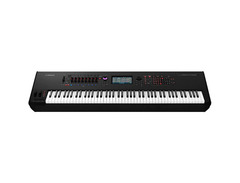


The left top of the synth contains eight endless rotary knobs, which mark the assigned parameter level on the external circular light ring – and follows the change of position, of course. This synth just begs to have knobs twisted, faders pulled, buttons pushed and assigned, etc.
#YAMAHA MONTAGE 6 FULL#
Though FM synthesis may be a difficult to get your programming head around, it can be great for making percussive sound (dreams and nightmares from the 1980s are full of DX-7 clavs and plucked sounds), ringing bells like living downstairs at Notre Dame, or long evolving soundscapes that have escaped from a feedback zoo (still one of my favorites).īut the Montage is much more than just another pretty synth with stacked stats: it's made for live performance. If you don't understand the basics of FM, there are presets to help you get up to speed.

The FM synth uses another 128 stereo oscillators, available in 88 different algorithms arranged in up to eight operator configurations. Although you can probably find a 6 GB triangle sample library for your computer, Yamaha has been refining their AMW2 library for a long time, and the acoustic instruments sound fantastic when soloed and are eminently usable in a multitimbral composition. The Montage has a lot more "there" there, however, that's anchored by a superior AMW2 playback engine, firing 128 stereo polyphonic "voices" while using almost 6 GB of the onboard samples for playback – including drums. It is a descendent of last century's Yamaha SY77 synth, which also employed an AWM (Advanced Wave Memory) engine for sample-based playback with a separate, Frequency Modulation (FM) engine for, well, FM synthesis. This is a happy thought, since the Montage is a fantastic synth. Now, I can't promise your Montage will still be touring in 40 years, but it's possible. I still use those Yamaha NS-500s and matching amp in my home studio. About 40 years ago I purchased monitors for a home studio before such things were common.


 0 kommentar(er)
0 kommentar(er)
